Hello and welcome to part two of our series on what the hell we mean when we say “top,” “bottom” or “switch”! Last week we talked about bottoms and submissives, and this week we’re talking about tops and dominants. Let’s get into it.
![]()
The Tops, Bottoms and Switches Sex Survey
Three weeks ago, I presented you with a survey about these slippery words, and over 3.6k people showed up to share their tops and bottoms with me. These are the demographics of the respondents:
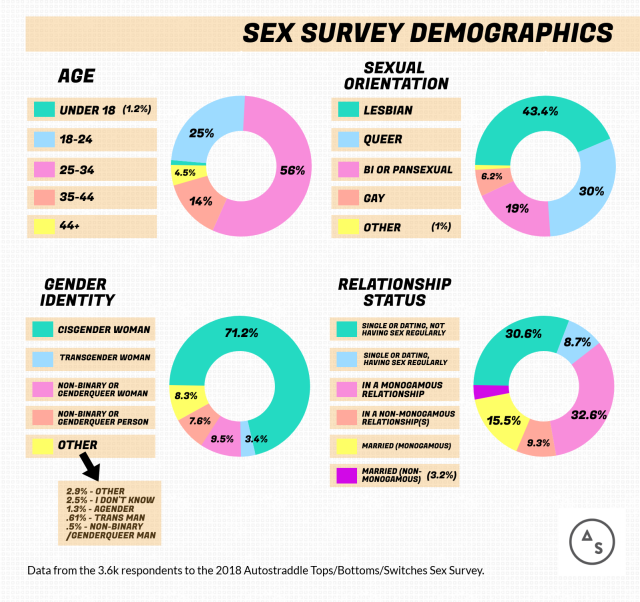
Demographics of Sex Survey Respondents // Age: Under 18 (1.2%), 18-24 (25%), 25-34 (56%), 35-44 (14%), 44+ (4.5%) // Sexual Orientation: Lesbian (43.4%), Queer (30%), Bi or Pansexual (19%), Gay (6.2%), Other (1%) // Gender Identity: Cis woman (71.2%), Trans woman (3.4%), Non-Binary or Genderqueer Woman (9.5%), Non-Binary or Genderqueer Person (7.6%), Other (8.2%) // Relationship Status: Single or Dating, Not Having Sex Regularly (30.6%), Single or Dating, Having Sex Regularly (8.7%), In a Monogamous Relationship (32.6%), In a Non-Monogamous Relationship (9.3%), Married & Monogamous (15.5%), Married & Non-Monogamous (3.2%)
I’ll be going through the data gradually over the course of the month — next week we’ll talk about switches and people who don’t employ these terms at all. We’ll also talk about sub-identities (bratty bottom, power bottom, service top, etc.) and we’ll look at the data as a whole and how it intersects with various identities and demographics. Each week’s data will build on last week’s and will be very satisfying for nerds and fans of sex.
How Many Tops Are Out There?
Despite all the talk of tops and bottoms within the queer community, our survey revealed that people who identify specifically as tops or bottoms are in the minority overall. Also, there are slightly more bottoms out there than tops.
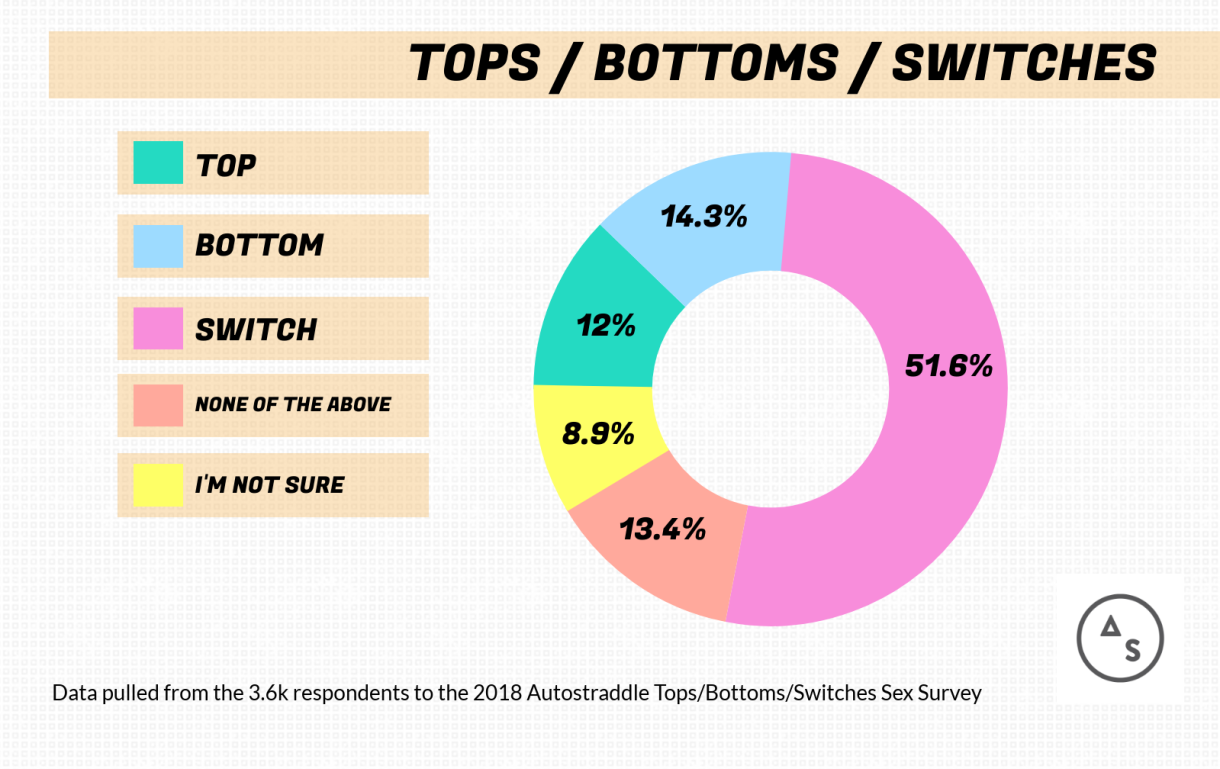
Tops: 12% // Bottoms: 14.3% // Switches: 51.6% // None of the Above: 13.4% // I’m Not Sure: 8.9%
What Is Topping?
Before queer women’s culture adopted top/bottom as terminology relevant to non-kinky sex, the terms were primarily used by gay men, or in kink or BDSM contexts by both straight and LGBTQ+ people. For now, a few things are clear from our surveys: “top” is easier to define than “bottom,” there’s more consensus on favored acts among tops versus bottoms, and there seems to be a more clear-cut distinction between “top” and “dominant” than between “bottom” and “submissive.”
![]()
What Do Tops Like To Do In Bed?
We asked survey-takers to indicate their passion for giving and receiving a variety of sexual acts, and also asked them to define what “top” means to them. We’ve included some of the most popular activities below. (Note that scissoring/dry-humping was not included on the survey as it has no clear giving/receiving dynamics.)
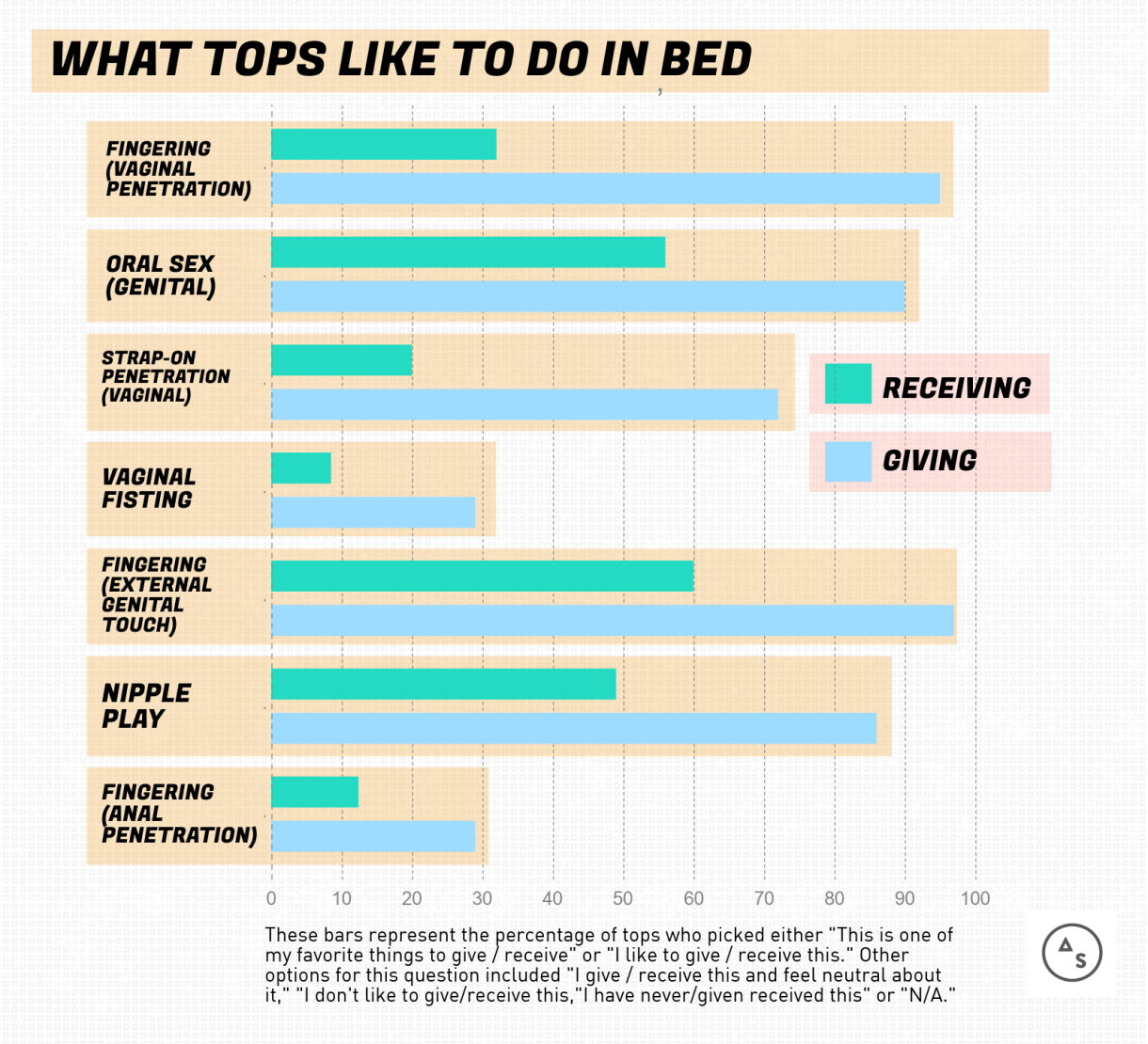
WHAT TOPS LIKE TO DO IN BED – Vaginal Penetration: Receiving (32%), Giving (95%) // Oral Sex (Genital): Receiving (56%), Giving (90%) // Strap-On Penetration (Vaginal): Receiving (20%), Giving (72%) // Vaginal Fisting: Receiving (8.5%), Giving (29%) // Fingering (External Genital Touch): Giving (97%), Receiving (60%) // Nipple Play: Receiving (49%), Giving (86%) // Anal: Receiving (12.4%), Giving (29%)
The chart above reveals which activities inspired tops to declare “this is one of my favorite things to give/receive” or “I like to give/receive this.” They could also express neutral feelings about a given act, say they didn’t like to do it, say they’d never done it or pick “N/A.” But “I give this and don’t like it” was selected very rarely — exactly zero tops explicitly don’t like giving vaginal penetration, for example, and the only sex acts that inspired more than five tops to pick “I give this and don’t like it” were anal oral sex (six respondents don’t like it) and anal penetration (seven respondents don’t like it).
There was a greater consensus among tops versus bottoms when it comes to preferred acts. For example, 95% of tops like to penetrate vaginally; 80% of bottoms like to receive said penetration. Of course, it’s worth noting that not all people who took this survey have vaginas to penetrate, but removing the group least likely to have a vagina (trans women) from our bottom data did not make a statistically relevant impact on that percentage. The very definitions of “giving” and “receiving” lend themselves to greater top consensus for, as it was written Pat Califia’s 1988 lesbian sex guide Sapphistry: The Book of Lesbian Sexuality: “[the top’s] power is always limited by the needs and capabilities of the bottom.” Similarly, there are far more bottoms interested in finger-fucking (68.6%) than there are tops who want to get finger-fucked (32%).
![]()
So, “Topping” Can Mean…
Being in Charge of the Encounter
The most consistent descriptor in the open-form answer descriptions was that of the top being “in control” or “in charge” of the sexual encounter, or otherwise “leading the way” or being the “more active” or “dominant” partner. “You primarily enact, direct, or conduct the activities,” said one butch top. “Someone who is the team captain for the activity,” wrote one bisexual top, adding: “Someone who often initiates or lovingly takes control. Someone who is taking on the responsibility of giving the other party or parties a very good time.”
“Emotional leadership labor trumps physical action here,” wrote a queer femme dominatrix regarding her definition of “top.” “Often a top is the one fucking, etc. but a top can be licked or fucked or whatever if they are controlling the scene.”
Preferring to Be The Penetrator or The Giver
In gay men’s sexual culture, tops penetrate and bottoms are penetrated, which came up a lot in respondents’ definitions, too. One tomboy femme lesbian top described tops as “the partner on the giving end of sex, whether that be oral, penetrative, digitally penetrative, etc.” As the above chart shows, tops were much more interested in receiving external stimulation (oral or digital) than penetration, although many tops enjoyed penetration as well.
“The top is the more ‘active’ partner in bed, the one who wears the strap on and likes to do ‘the fucking’ even if the bottom is saying exactly what she wants done,” said one lesbian femme top.
“The giver,” which is also the title of a good book and a bad movie, was another popularly employed phrase. Tops were frequently described as “being on the giving end of sex.” Which brings me to…
Giving But Not (or Rarely) (or Secondarily) Receiving
Although the only word that means “does not want their genitals touched” is “stone,” a few survey-takers seemed to assign a level of “stone” to topping. One soft butch gay woman defined “top” as “someone that strictly ‘gives’ and does not look to be touched in any way,” but most descriptions focused not on giving exclusively but rather on preferring or prioritizing giving. “She will give and receive,” wrote one queer tomboy, “but would be ok just giving.”
Getting Off On Getting Somebody Else Off
The “giving” dynamic isn’t just about preferring to perform specific sexual acts, it’s about deriving pleasure from doing so. “Tops prefer to give sexual pleasure more often than they receive it,” wrote one gender-fluid Stud/AG. A tomboy femme top described topping as “someone who gets pleasure from giving as much as receiving, if not more.”
A top “gets pretty close to comparable amounts of enjoyment out of getting a partner off as themselves getting off,” wrote one soft butch top. Another soft butch lesbian top described her topping as “preferring to touch rather than be touched for pure sexual and emotional excitement and fulfillment.” Yet one more soft butch lesbian top wrote, “When I say I am a top, I mean I am a person who primarily experiences sexual pleasure by touching my partner rather than having my partner touch me.”
The lesbian femme top I quoted in an earlier section wrote that sex isn’t about coming for her — “if I want to get off, I’d rather masturbate.” Although sex isn’t about coming for a lot of people, regardless of top/bottom identity, for those who want orgasming to be part of sex, “the bottom comes first” might be a part of the dynamic. Along those lines, a bisexual lazy femme/soft butch top described her position as the “person who likes to be more dominant and is focused on giving pleasure and turned on by that (usually comes after their partner).”
Kinky Tops and Dominants
25% of tops identify as kinky (compared to 40% of bottoms and 27% of switches) and 53.5% said they don’t identify as kinky but sometimes enjoy kinky sex (compared to 46% of bottoms and 27% of switches). Within the world of kink, “topping” has different connotations than it does for vanilla sex. According to The New Topping Book, which is focused on BDSM play specifically, “top is an umbrella term that includes people who like to play on the giving end of sensation and pain, bondage, control and discipline and all the other activities that make up the universe of BDSM.” In a kink context, “dominant” is one of many terms enveloped by that particular umbrella.
What Do Kinky Tops Like?
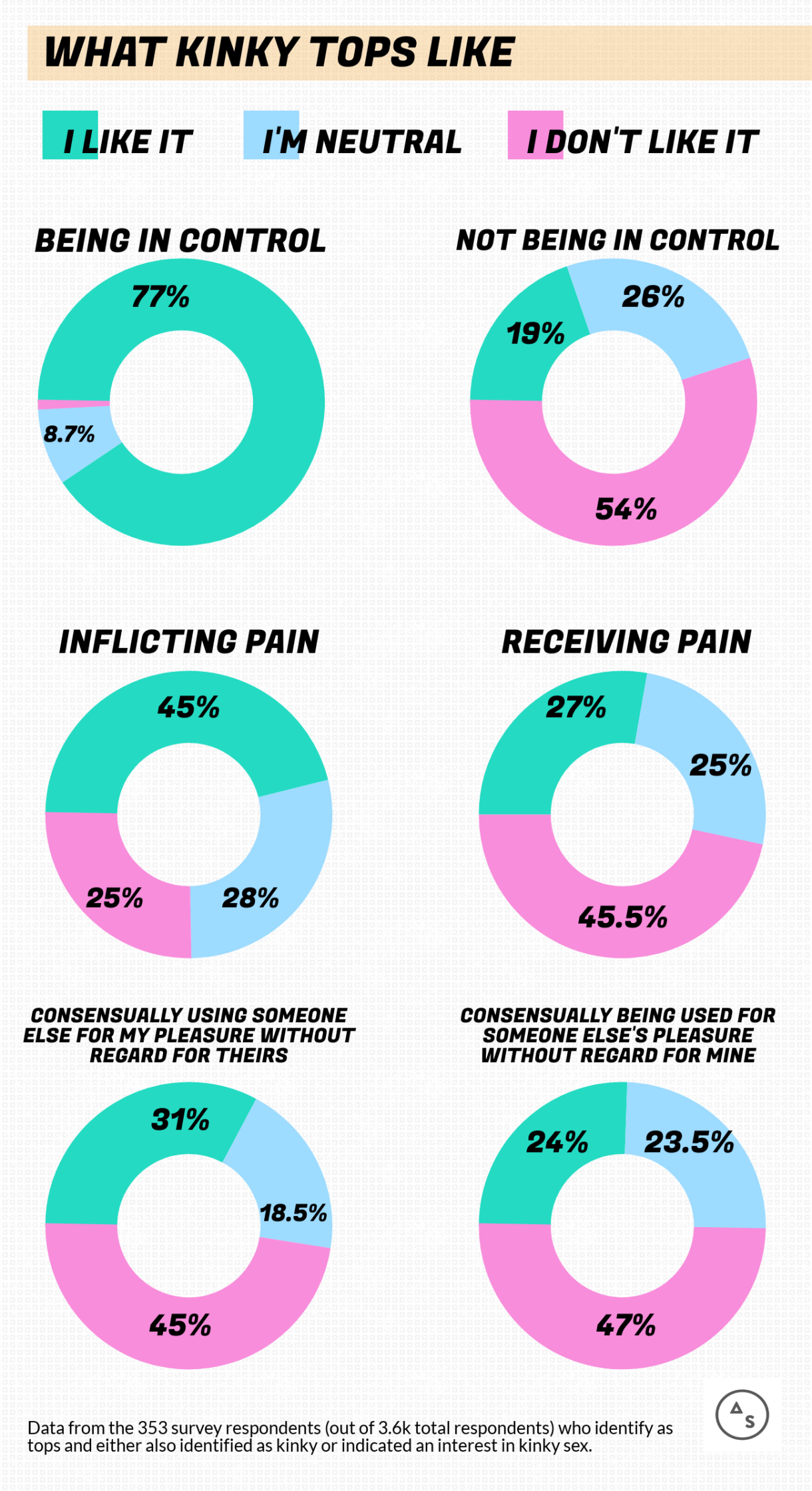
In comparison to the above data, 6% of non-kinky tops like inflicting pain and 3.8% like using someone else for pleasure with no regard for theirs. However, a full 86% of non-kinky tops also like being in control of the sexual experience, which is a very small disparity (4%!) compared to the disparity amongst kinky and non-kinky bottoms — 91% of kinky bottoms like not being in control, compared to 62% of non-kinky bottoms. The vulnerability inherent in “not being in control” would seem, then, to be less favored overall than its reverse, and perhaps less intrinsic to vanilla “bottoming” than being in control is to vanilla “topping.”
Within the context of kink, what separates the concept of “top” from “dominant”? In consultation with our former NSFW editor Carolyn, we decided to separate “tops” and “dominants” on our survey. Only kink-identified survey-takers were subjected to an additional survey page with questions about dominants/submissives and sub-identities therein, and now we’re gonna talk about those results.
![]()
How Many Dominants Are Out There?
Of the 435 self-identified tops on our survey, only 115 identify as kinky, and only 87% of those (92 people total) as dominants. Meanwhile, of our 525 bottoms, 190 identify as kinky, and 172 as subs — meaning that subs outnumber doms 2:1. 3.4% of kinky tops identify as submissives, 8% as switches and 2.24% as “none of the above” or “not sure.”
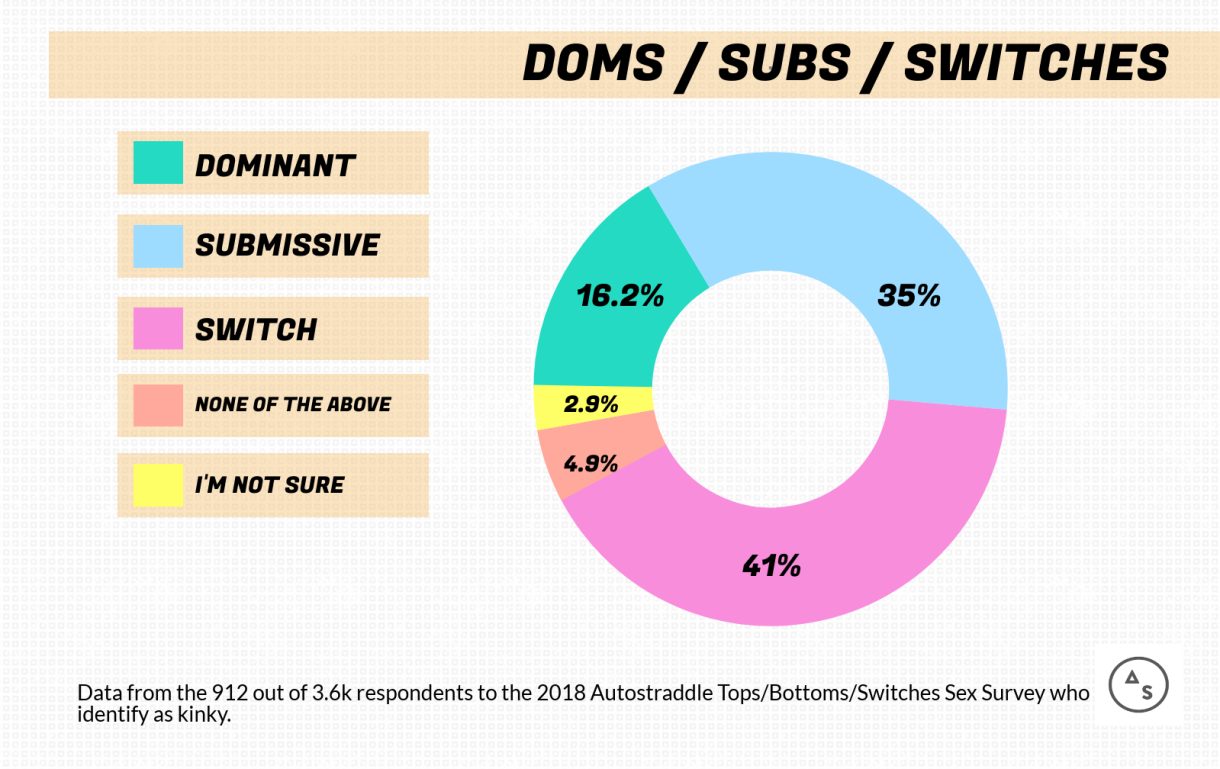
DOMS / SUBS / SWITCHING: 16.2% Dominant, 35% Submissive, 41% Switches, 4.9% none of the above, 2.9% I’m Not Sure
So, is the alleged Dom Shortage real? According to Carolyn: “On one hand, talking about a ‘Dom shortage’ implies a sort of commodification of Doms that turns subjects into objects; leads to objectification; and belies the fact that among people of any sexuality it’s challenging to find a person who is a skilled and respectful counterpart to whatever sex or play you’re trying to have, who is good at communicating, whose relationship orientation matches up with yours, and who you also find hot intellectually and emotionally and sexually in both immediate and deeper ways. And on the other hand, totally.”
Since we’re here anyway, I feel inspired by a higher queer power to also note that concepts like “dom shortage” and “top shortage” (which are often exhaled in the same breath as concerns over a so-called “butch shortage,”) create a paradigm of scarcity that can easily influence those seeking tops or doms to feel a certain level of desperation or ambient cultural anxiety that leads one to hang onto their top for dear life, against all odds, even when the odds are immense. The New Topping Book states this plainly to its top readership: “if you’re a heterosexual female, a lesbian, or a gay man… you as a top are in something of a buyer’s market.” If you’re a seller slash bottom, I encourage you to think critically about these ideas, be as picky as you damn well please while at the market, and never underestimate a suitable switch.
Why Is There a “Shortage” of Kinky Tops and/or Doms?
Here’s three theories:
1. Gender Stuff
Research of BDSM practitioners has shown women tend towards submission and men towards dominance and that women are more likely to be aroused by masochistic thoughts than men, who are more aroused by sadism. You’d expect those numbers to shift at least somewhat for queer women, and indeed they do — the aforementioned study revealed 8% of kinky women were dominants, and on ours, 16% of kinky cis, trans and genderqueer-identified women enjoy domming. Still, even with double the amount researchers found amongst (presumably?) straight women, the numbers remain skewed. The tendency towards subbing and away from domming was also reflected in our gender breakdown: 84.3% of our survey’s subs identify as women (cis, trans, or genderqueer), compared to 74% of doms, and non-binary people and agender folks were more likely to be doms than subs. But! Gay men seem to feel they have a top shortage as well, so maybe nothing means anything?
2. Learning Curve
Being a submissive certainly requires a great deal of work, including psychological preparation, building trust, understanding your boundaries, familiarizing yourself and testing your interest in various sexual options, reading your body and a developing effective methods of communication. Being a dominant, on the other hand, requires a lot of practical skill-building — from how to safely inflict pain to the literal knowledge of knots for rope bondage. It can be more intimidating to just declare oneself a dom, regardless of experience level, and go for it than the reverse. Cee, a non-binary dom I talked to while writing this post, recalled realizing pretty early into feeling dommy that it wasn’t something they could just do, they had a lot to learn to make sure they didn’t physically harm their partner. On our survey, doms were generally older and reported having more lifetime sexual partners than subs.
3. Expense
“The perception that you need to own a certain set of objects to be kinky is very much present,” says Carolyn. “And that stuff is expensive.”
![]()
The Difference Between Tops And Dominants
First, some language: “dom” is, as you may have guessed, short for “dominant.” “Domme” is a word for female doms specifically, but most of the women on our survey used “dom” regardless. “Dominatrix” is also a woman-focused word, usually used these days to refer to a professional dominant (or “pro-domme”) who does BDSM stuff with subs for money.
Now, a few themes arose in your answers about dom vs. top: dominant is kink-exclusive; topping is about physical actions whereas domming is about a mental/psychological dynamic; domming involves power play; and topping is an action but domming is an identity.
“As a domme, I expect certain protocol, etiquette and consideration,” wrote a bisexual femme dominant. “As a top, I expect to be on top in a sexual position.”
A queer agender ace dominant felt the difference was about a desire for control: “In my opinion, a dominant is more focused on an unequal power dynamic. A top can hit someone and enjoy their range of reactions without necessarily taking control of the entire situation. ‘Top’ can also just mean ‘someone who prefers to penetrate’ without kink in the picture at all, but ‘dominant’ to me means control.”
There’s also a less apparent physical giving/receiving dynamic. “Sometimes dominant/top and submissive/bottom don’t line up,” wrote a bisexual woman who also identifies as a sadist. “For example, you might find someone who enjoys control and feeling like they have power over their partner, but also likes being spanked, and they might identify as a dominant bottom or power bottom.” The possibility of a dom being a bottom came up in more than a few answers.
What a sub is willing to do or interested in doing is negotiated beforehand, but once a scene or sexual encounter begins, the dom is in charge of what happens within those boundaries. “A dominant person relishes in taking control not just of the sexual encounter, but of the body/behvior of another person,” wrote a stone transmasculine agender person. “To them, it is the ability to decide who feels what when (for example, I might chose to cause a sub pain because I want to, not because they are asking me to) that brings pleasure.”
“A dominant is more clearly involved in a power exchange, while a top might just be the more active partner,” said one non-binary dom on our survey. “Dominating, for me, is often about giving rather than taking — giving sensations and experiences that the other person wants, while maybe seeming to have control over the scene or situation. Doms might actively create all sorts of different kinky experiences for their bottom. Things that both partners want, that the dom is more often guiding or administering.”
![]()
Finally: On Gender Presentation and Topping
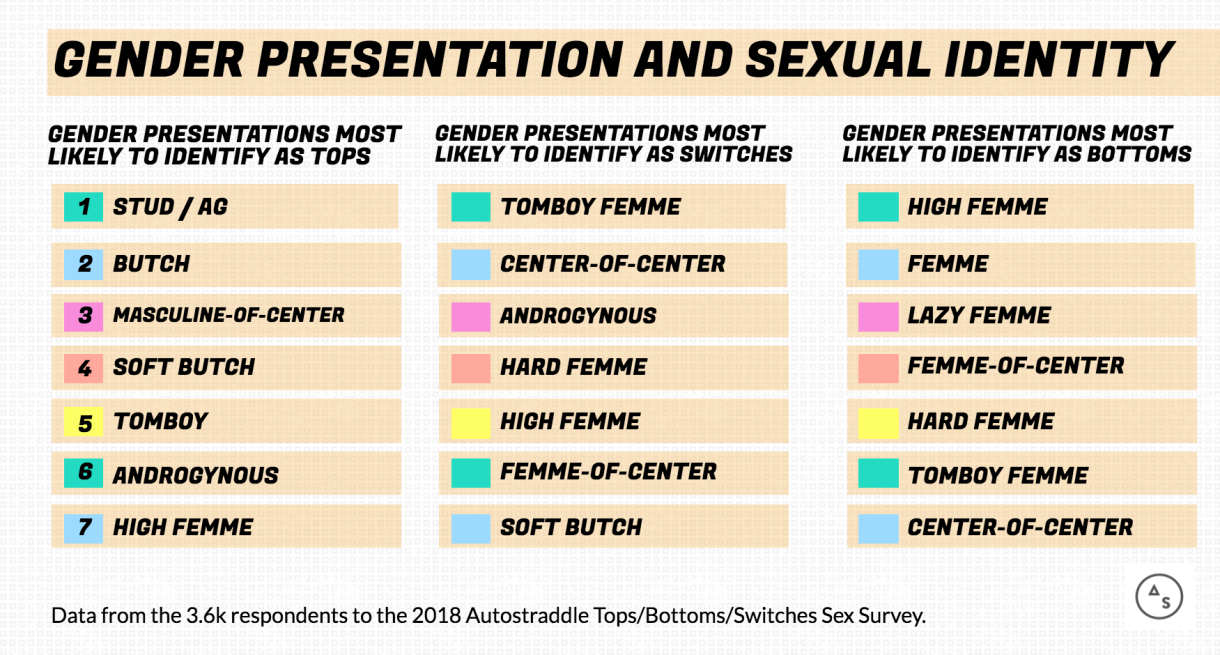
Back in the day, “butch” and “top” were considered inexorably linked, and that correlation remains common today, but it’s hardly universal or absolute. “Switch” was, as indicated in this post’s first chart, the most popular identification amongst our survey-takers, and that remains true when the data is segmented by gender presentation. A lot of survey-takers talked about enjoying a butch/femme = top/bottom dynamic in their sexual lives, but others expressed frustration about assumptions. “Often people assume I am more of a top,” wrote one self-identified versatile queer tomboy. “I have never had sex with someone who didn’t make an assumption that I would be dominant before they would. Tbh I think it’s because I’m hella butch. I also don’t get a lot of attention from other masc people. :-/”
“Previous femme partners have expected me to be more of a top based on being masculine-of-center, which is not what I prefer,” wrote one bottom-leaning switch.
“I’m a bisexual high femme,” wrote one survey-taker, “and I think this often translates into me being automatically perceived as a bottom, though I’m happiest being a switch most of the time.”
“I think at first I expected butch partners to be tops,” wrote one lesbian switch. “But that hasn’t really proven true and also ~surprise!~ I like being a top sometimes despite IDing as mostly femme!”
Some femmes talked about enjoying the subversion of gendered expectations within topping. “I STRONGLY identify as a Femme Top,” wrote one, “and bring many elements of that gender subversion into my dominance.” Another wrote, “I think my femme presentation allows for a lot of power and gender play in my role as a domme.”
How masculine/feminine energies and presentations actually play out in bed and attraction — including the impact of dysphoria on sex — is a larger topic for a later post. Y’all shared so many stories on this topic that I’m eager to discuss! But this post is already very long, so I will set you free upon the world at this time.
In conclusion, one time a cis man paid me to kick him in the balls for ten minutes and it was the easiest $160 I’ve ever made.
C U Next Tuesday to talk about switches and people who don’t identify as tops or bottoms!
Lesbian Sex 101 is Autostraddle’s series on how to have lesbian sex for queer women and anyone who finds this information applicable to their bodies or sexual activities. Employment of the term “lesbian sex” in this post uses “lesbian” as an adjective to describe sex between two women or people who identify with that experience, regardless of the sexual orientation of the two people involved.
Sex ed almost never includes queer women or our experiences, so we’re exploring pleasure, safety, relationships and more to make that information more accessible.
A lot of the language in these posts is intended to make them easy to find on search engines.Some of the body parts we talk about will be yours or your partners’ and some won’t. Some of the pronouns will be yours or your partners’ and some won’t. Some of the sexualities will be yours or your partners’ and some won’t. Some of the language will be yours or your partners’ and some won’t. Take what you want and what applies to you or what you can make apply to you and your partners and your experiences, and leave the rest!



Honestly, reading all of these survey articles is incredibly enlightening and educational, and also I’ve never felt more confused about my identity.
Yep and yep
Hard same.
honestly i have repeatedly re-categorized the dynamics of all my past relationships like three times each throughout the process of writing these
“Never underestimate a suitable switch”
Honestly, that’s the buried takeaway from this whole damn article
lol, yes. I’m heartened by how many folks ID as switches though in relationships I always worry I go in switch, and end up playing a recurring role as a top or bottom, much to my chagrin.
what a wonderful sentiment indeed ♥️
“In conclusion, one time a cis man paid me to kick him in the balls for ten minutes and it was the easiest $160 I’ve ever made.”
Well, for me this could mean one of the best orgasms in history…for the kicker of course.
In conclusion, this article’s concluding sentence is one of the best article-concluding sentences ever. Concluding Sentence Award for Riese.
“Simply topping survey and analysis, wouldn’t you say?”
“Definitely my dominant impression.”
“They certainly worked out all the kinks, I would say.”
Snaelle! ?
Just a little loving pun-ishment…
Of corset would be you !
HEY I recognize that pun – this is highway brabbery!
Top-notch highway brabbery: your money and your wife.
I can-knot believe you. (You and Deli Twotone may be tied for a comment award.)
Pun game is off the hook, but also this photo is giving me the vapors. The lady vapors.
“Someone who is taking on the responsibility of giving the other party or parties a very good time.” This person nailed it. No pun intended.
Riese, I love this series! Thank you thank you for doing this work.
Right?? I was taking mental notes the whole time like, ok yep these are touchstones for me, gotta focus more on that. I feel like that sentiment works really well for me as a service top.
Great job as usual, Riese
i wonder if the shortage of tops in the queer community also has to do in a gender sense with not wanting to be associated with dominance in a toxic masculinity way, especially when top means dominant or in control in a kinkier sense and not just who’s the penetrating partner. i know i skew way more dominant than i let myself ever be because i’m concerned with partners or in discussing it in general, it will be read as threatening or associated with other negative qualities of toxic masculinity. on the second point, i would also guess the queer community is more receptive to the “leader in the streets, oh god someone else shake it up and take away my control freak stress and be in charge in the sheets” deal than cis straight dudebros are at relinquishing their alpha male control/masculinity proving in bed. so that probably gets rid of some potential tops too.
yeah what you said about more women being comfortable with submission than cis het men are reminded me of the new inquiry article i think i linked to in this piece — are we correct to label it a top shortage, or is it really… A BOTTOM SURPLUS?
Well, this analysis gives me a new perspective, I was kinda stuck on Cole Porter’s definition…
https://www.youtube.com/watch?v=X0oKUpIqwek
Haha Love it!
very good write
This was one of the most interesting reads I’ve read all year—and I’m a grad student studying to be a sex therapist. Thank you for this!
After going over a handful of the blog articles on your site, I really appreciate your way of writing a blog.